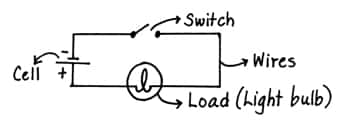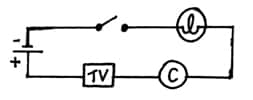– All electrical devices have an electric circuit, also known as a path for electrons to flow.
– All circuits have at least four parts:
- An energy source (we’ll be using batteries which are also called “cells”).
- An electric load (an electrical device used to convert electricity to another form of energy. We’ll be using light bulbs).
- A switch (this “completes” the circuit allowing electrons to flow in a circular path), and
- Everything is connected together with wires (usually made of copper and covered in plastic).
– Without a load to convert the electricity into another form of energy, the wire creates a “short” circuit, which can cause sparks or fires.
– Electrical circuits can be drawn with symbols that are internationally recognized. Drawing circuit diagrams before building a circuit will allow you to better understand how to accurately build the circuit.
– Let’s look at the symbols we’ll be using:
– The simplest circuit you can build is as follows:
– When constructing circuits make sure to pay close attention; remember: small amounts of electricity can be very dangerous.
- Make sure your hands are dry and that you’re standing on a dry surface.
- Do not use batteries (cells) that appear damaged.
- Do not use connecting wires if they appear frayed or damaged.
- Only operate circuits when instructed by your teacher.
- Always build circuits with the switch OPEN.
SERIES AND PARALLEL CIRCUITS
– There are two different types of electrical circuits: series circuits and parallel circuits.
– Series Circuits
- In a series circuit, the electrons only have one path to travel.
- Many simple electrical devices are wired in series, such as flashlights and many battery-operated devices.
- Most series circuits only have one electrical load, however, more loads can be added.
- For example:
- The simplest series circuit is the one we just looked at:
- More loads can be added as follows:
- Old Christmas lights used to be wired in series. This meant that if one light burned out, the entire strand of lights went out. How could you then figure out which light burned out?
– Parallel Circuits
- In a parallel circuit, the electrons have more than one path that they can take.
- Parallel circuits have a very important advantage over series circuits; they allow you to turn off one load while keeping other loads on.
- Most houses are wired in parallel with different switches to control different electrical loads.
- New Christmas lights are now wired in parallel so that when one light burns out, it is easy to find and replace that light since all the other lights stay on.
- Here is an example of a parallel circuit:




